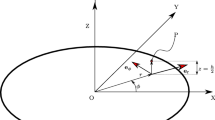Abstract
In the nonrelativistic approximation of fluctuation electrodynamics, using the specular reflection model and the nonlocal dielectric permittivity of a metal, simple analytical expressions are obtained for the friction forces in the particle-plate and plate-plate configurations at relative motion of bodies with constant velocity. It has been shown that at distances of about 1–10 nm, for an Au nanoparticle (or a gold plate) moving near another similar plate at rest, the dissipative forces are 2–4 orders of magnitude higher than when using the Drude local dielectric function.





Similar content being viewed by others
REFERENCES
M. Aspelmeyer, T. J. Kippenberg, and M. Marquardt, Rev. Mod. Phys. 86, 1391 (2014).
K. A. Milton, J. S. Hoye, and I. Brevik, Symmetry 8, 29 (2016).
G. V. Dedkov and A. A. Kyasov, Phys. Usp. 60, 559 (2017).
A. I. Volokitin and B. N. J. Persson, Electromagnetic Fluctuations at the Nanoscale. Theory and Applications (Springer, Berlin, Heidelberg, 2017).
G. L. Klimchitskaya and V. M. Mostepanenko, Vestn. SPb. Politekh. Univ., No. 1, 41 (2015);
Mod. Phys. Lett. A 34, 2040007 (2020).
R. Esquivel and V. B. Svetovoy, Phys. Rev. A 69, 062102 (2004).
V. Despoja, M. Sunjic, and L. Marusic, Phys. Rev. B 75, 045422 (2007).
V. Despoja, P. M. Echenique, and M. Sunjic, Phys. Rev. B 83, 205424 (2011).
D. Reiche, D. A. R. Dalvit, K. Busch, and F. Intravaia, Phys. Rev. B 95, 155448 (2017).
R. H. Ritchie and A. L. Marusak, Surf. Sci. 4, 234 (1966).
R. Nunez, P. M. Echenique, and R. H. Ritchie, J. Phys. C 13, 4229 (1980).
F. J. Garcia de Abajo and P. M. Echenique, Phys. Rev. B 46, 2663 (1992).
G. V. Dedkov and A. A. Kyasov, Surf. Sci. 604, 562 (2010).
G. V. Dedkov and A. A. Kyasov, Phys. Solid State 44, 1779 (2002).
T. L. Ferrell, P. M. Echenique, and R. H. Ritchie, Solid State Commun. 32, 419 (1979).
E. M. Lifshitz, Sov. Phys. JETP 2, 73 (1956).
N. D. Mermin, Phys. Rev. B 1, 2362 (1970).
J. B. Pendry, J. Phys.: Condens. Matter 9, 10301 (1997).
V. G. Polevoy, Sov. Phys. JETP 71, 1119 (1990).
G. V. Dedkov and A. A. Kyasov, Phys. Solid State 60, 2349 (2018).
Author information
Authors and Affiliations
Corresponding authors
Ethics declarations
The authors declare that they have no conflicts of interest.
Additional information
Translated by G. Dedkov
APPENDIX A
APPENDIX A
In [20], transforming the general expression for the friction force obtained in the Rytov–Levin–Polevoy theory [19] with the local dielectric permittivity ε(ω), we obtained a formula for the friction force of two parallel thick plates in the case of their relative motion with nonrelativistic velocity V/c \( \ll \) 1 (values related to plates 1 and 2 are provided with indices 1, 2)
Here q = \(\sqrt {{{k}^{2}} - {{{(\omega {\text{/}}c)}}^{2}}} \), q1 = \(\sqrt {{{k}^{2}} - {{\varepsilon }_{1}}{{\mu }_{1}}{{{(\omega {\text{/}}c)}}^{2}}} \), q2 = \(\sqrt {{{k}^{2}} - {{\varepsilon }_{2}}{{\mu }_{2}}{{{(\omega {\text{/}}c)}}^{2}}} \), “tilde” means that arguments of the dielectric permittivities and magnetic permeabilities ε1, 2, μ1, 2 are taken at ω– = ω – kxV, and
and the Qμ value is determined by the same expression with the replacement ε → μ. Formula (A.1) describes the frictional force acting on plate 1, moving in the direction of the x axis with a constant speed V. Its important features are the absence of the Fresnel reflection coefficients in an explicit form and the absence of the separation of the contributions of homogeneous and inhomogeneous modes on the axis of wave vectors. From (A.1), in the linear approximation in velocity at t1 = T2 = T, it follows (see (23) in [20])
and for T1 = T2 = 0, respectively, is the expression for the quantum friction force [18, 20]
Here Δiε = (εiqi – qi)/(εiqi + qi), i = 1, 2, Dε = 1 – \({{\Delta }_{{1\varepsilon }}}{{\Delta }_{{2\varepsilon }}}\exp ( - 2kl)\), and for the corresponding magnetic contributions we should replace ε → μ. We note that in Section 3, the case of nonmagnetic materials when μ1, 2 = 1, is considered.
Rights and permissions
About this article
Cite this article
Dedkov, G.V., Kyasov, A.A. Quantum Friction and van der Waals Friction in Configuration Particle–Plate and Plate–Plate: Nonlocal Effects. Phys. Solid State 62, 1479–1486 (2020). https://doi.org/10.1134/S1063783420080107
Received:
Revised:
Accepted:
Published:
Issue Date:
DOI: https://doi.org/10.1134/S1063783420080107



